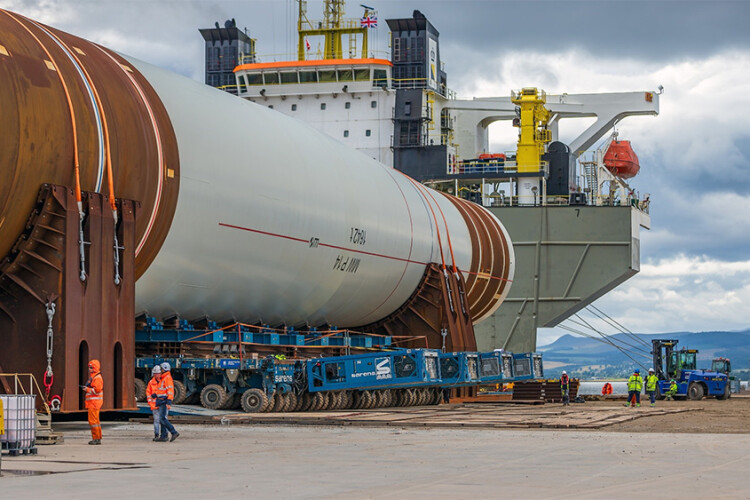Dutch offshore infrastructure specialist Boskalis and its Belgian opposite number DEME used a fleet of barges and crane vessels to transport and install the monopiles – each weighing up to 2,000 tonnes – between October 2023 and June this year.
The huge XXL monopiles were deemed necessary due to the large size of the 14.7MW Siemens Gemesa turbines that will sit on top of them and the depth of the water – up to 54m – in which they are installed.
The piles are the largest ever to be handled in the UK, measuring up to 10m in diameter and up to 85m in length. They were built by Spanish firms Navantia Seanergies and Windar Renovables at Navantia’s Fene shipyard in A Coruña, northern Spain and shipped by Boskalis to the port of Invergordon last year.
Unloading and storing the monopiles was undertaken by SarensPSG – a joint venture between Belgian heavy-lift specialist Sarens and PSG Marine & Logistics, a Scottish heavy-lift and transport firm specialising in the offshore sector.
Monopile installation at Moray West started in October 2023, with Boskalis vessel Bokalift 2 installing the first phase. In February this year, DEME’s crane vessel Orion arrived to install the remaining 29 monopiles.
Piling was completed in April. DEME’s jack-up rig Apollo, which arrived in Scotland at the beginning of the year, then took over to install the transition pieces which connect the monopile foundation to the main turbine tower.
The Moray West offshore wind farm is being developed by Ocean Winds, a joint venture between EDP Renewables and Engie.
Lateral thinking solves riverside piling conundrum
Contractor VolkerGround Engineering has employed a novel piling technique on its £31m contract to build the New Wear high-level footbridge in Sunderland.
Parent company VolkerStevin is employed by Sunderland City Council under a two-stage early contractor involvement (ECI) contract to design and build the footbridge as part of the Riverside Sunderland Masterplan.
The bridge’s north pier is located below a high bank on the edge of River Wear and excavating an access route to enable a piling rig to install the piles was not possible.
Constraints on river working also meant that a traditional approach could not be adopted.
In collaboration with VolkerGround Engineering, the team devised a bespoke cantilevered piling frame to overcome the access, design and environmental constraints.
The cantilevered piling frame enabled the piling rig to track out from ground level at the bottom of an access slope and position itself over the permanent pile location.
According to VolkerStevin, this approach not only enabled the successful completion of a critical element of the project but has also set a benchmark for future projects.
VolkerStevin project director Mark Denham, said: “We are no strangers to overcoming complex engineering challenges and the innovative cantilevered piling frame was a crucial part required for the success of this project.
“The absence of similar existing solutions prompted extensive research across different sectors. We rigorously evaluated potential solutions based on health and safety, environmental impact and buildability, leading to the development of this preferred solution from concept to detailed design,” added Denham.
The same frame was used for piling operations to both the north and south piers with fabrication, alterations and testing carried out on site.
Piling to the south pier also required an imaginative approach to prevent loading to an old wall. For this the team designed two rows of temporary piles, the front row in compression and the rear in tension. From here it was possible to create a foundation to support the fully-cantilevered piling frame and install the permanent piles with no loading placed on the wall.
When complete, the new bridge will be 10m wide, 30m high and over 250m long.
It will provide access to both pedestrians and cyclists, creating improved connections between the city centre and the Sheepfolds area.

Specialist support for drainage scheme
Nineteen heavy-duty Premier trench boxes from Groundforce Shorco have been used in the construction of a groundwater storage tank on a site in Kent.

Specialist contractor Gallagher Group is carrying out the groundworks for the new Medway Maritime Academy, a new secondary school in Strood, for Medway Council. The main contractor on the project is Bowmer & Kirkland.
Gallagher called in Groundforce Shorco to help support a 35m-long, 4m-wide excavation to allow the installation of a precast concrete culvert comprising 76 segments, each weighing 14 tonnes. The culvert will be used to store surface-water run-off and control its flow to prevent flooding.
A long, deep excavation was required to install several of the 3m wide by 2m deep concrete segments at a time. To support the excavation, Groundforce Shorco supplied its 4m-deep Premier trench boxes, installing 10 for the first batch of segments and a total of 19 altogether.
The excavation progressed in sequence, with two contiguous 35m-long excavations, one supported with 10 boxes and the other with nine. This allowed the greatest possible length of culvert to remain exposed for waterproofing by specialist supplier Waterseal before back-filling.
As one length of culvert was completed, the trench boxes were removed and re-installed ahead of the next 35m length. The total length of the culvert is approximately 200m.

Cementation to sink 1,500 piles on Sheffield industrial site
Cementation Skanska has begun piling works for construction of the UK’s largest open-die forge at Sheffield Forgemasters’ Brightside Lane site.
The piling specialist will construct a 200-metre long secant pile wall for the new forge, between eight and 10 metres deep.
In total, some 1,500 piles will be required for the project. Of these, the majority will be installed using a continuous-flight auger (CFA) rig with approximately 300 being rotary-bored piles.
The foundations will support a 13,800m2 building containing a new 13,000-tonne heavy forging press, furnaces, quenching pits and cranes.
Vinci Building has a £138m contract to deliver the forge building while state-owned Sheffield Forgemasters is undertaking a site-wide recapitalisation programme in support of the UK’s defence programmes.
Demolition and remediation works have been underway for the past seven months, including removal of internal steel structures, stabilising the ground, removal of any contaminants, processing more than 25,000m3 of spoil, and crushing 4,500m3 of old concrete to clear the site.
The forging line is set to be operational in the summer of 2027 and will be complemented by a new machining facility, which is currently being scoped, containing multiple versions of the world’s largest, most advanced, five-axis vertical turning lathes.

Scots unveil modular precast beams
Scottish contractor Akela Ground Engineering has launched a precast concrete beam system which it claims could dramatically speed up the delivery of new homes.
The Abeam features a special pinned joint that allows ground beams to be prefabricated and installed in a matter of hours.
Akela says that the combination of off-site fabrication, accurate alignment and secure fastening ensure a robust, reliable and efficient way to connect precast ground beams.
The company has set up a dedicated fabrication facility at its headquarters at Thornliebank, near Glasgow where ABeams can be fabricated in a controlled environment. Akela has installed a low-carbon ground-source heating system for curing the concrete components.
The ABeam could help housebuilders lay foundations for up to three plots per day and it has already been approved and signed-off on live projects by the National House Building Council (NHBC).
Will Payne, general manager at Akela Ground Engineering, said: “After reviewing the precast ground beam options available on the market, we found many still had considerable downsides, the use of pile caps, insitu concrete and tie bars were common. This requires sequencing of works and could also be impacted by weather conditions, all of this leads to considerably longer installation times.
“Akela’s new ABeam precast system eliminates all of these issues and offers significant advantages in terms of construction install, performance and overall project quality,” he added.
Got a story? Email news@theconstructionindex.co.uk




